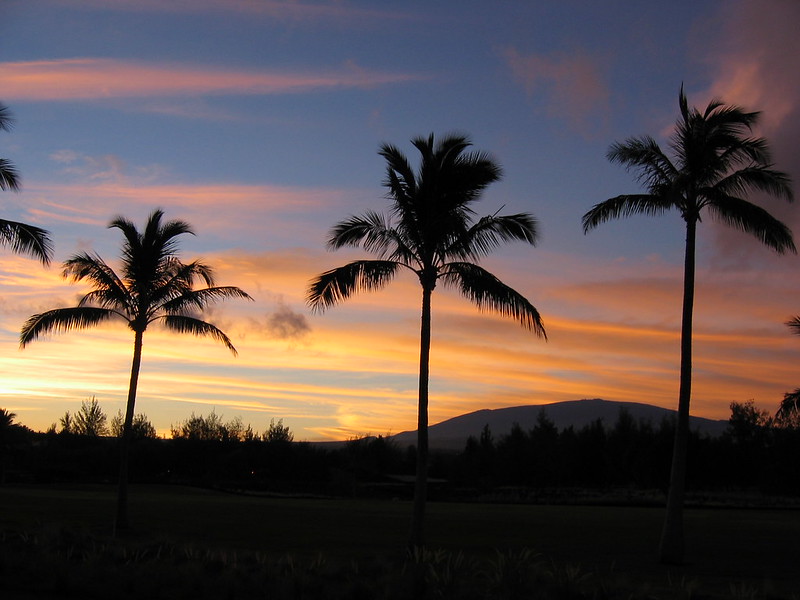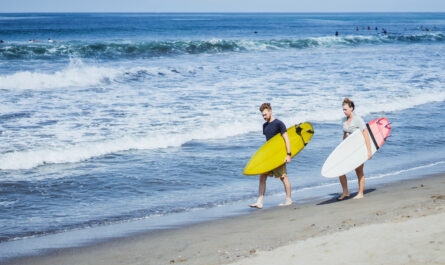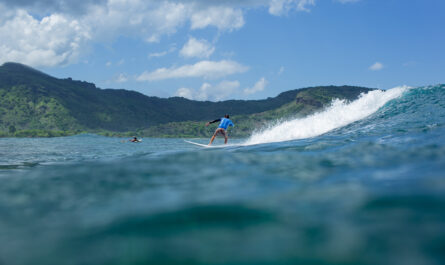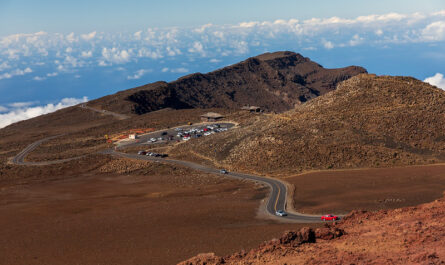Mauna Loa, located on Hawaii’s Big Island, is the largest active volcano on Earth, both in terms of volume and area. Rising 13,681 feet (4,170 meters) above sea level, it dominates the island’s landscape, covering more than half of the Big Island’s landmass. With a history spanning hundreds of thousands of years and frequent eruptions, Mauna Loa holds a special place in the natural and cultural landscape of Hawaii. This guide delves into the geological significance, history, and the various ways to explore and experience Mauna Loa.
1. Geological Significance of Mauna Loa
Mauna Loa is classified as a shield volcano, a type characterized by broad, gently sloping sides created by the flow of low-viscosity lava. Unlike steep stratovolcanoes, shield volcanoes spread out over vast areas, resulting in their wide base and relatively low profile. Mauna Loa’s sheer size is staggering—it stretches about 60 miles (97 km) long and 30 miles (48 km) wide. When measuring from its base, which lies on the ocean floor, Mauna Loa is about 33,500 feet tall, making it taller than Mount Everest.
Mauna Loa has erupted 33 times since its first documented eruption in 1843, with its most recent eruption occurring in 2022. Its eruptions are typically non-explosive, characterized by lava flows that travel long distances. Because of the large volume of lava it produces, Mauna Loa is closely monitored by scientists due to its potential to cause significant damage to nearby towns, including Hilo and Kona.
2. History of Eruptions
Mauna Loa’s volcanic activity dates back hundreds of thousands of years. It is estimated to be between 700,000 and 1 million years old and has played a major role in the formation of the Hawaiian archipelago. Mauna Loa and neighboring volcanoes, such as Kīlauea, are fed by a hotspot deep beneath the Earth’s surface, which creates the magma responsible for its eruptions.
Historically, Mauna Loa’s eruptions have been both frequent and significant. Its lava flows have occasionally threatened populated areas:
- In 1950, a major eruption sent rivers of lava flowing toward the coast at a speed of 6 miles per hour (9.6 km/h), reaching the ocean in under three hours.
- The 1984 eruption came dangerously close to the city of Hilo, but the lava flow eventually stopped just a few miles from town.
Despite its eruptions, Mauna Loa is not considered highly dangerous compared to other volcanoes, as its lava flows tend to be predictable and relatively slow-moving. However, monitoring the volcano remains critical due to the risk it poses to populated areas.
3. Cultural Significance of Mauna Loa
In Hawaiian culture, Mauna Loa is more than just a natural landmark. It is seen as a sacred site, deeply tied to the stories and beliefs of the Hawaiian people. The volcano is associated with Pele, the Hawaiian goddess of fire, lightning, and volcanoes, who is believed to live in the craters of Mauna Loa and Kīlauea. Hawaiians often make offerings to Pele, seeking protection from the destructive power of her lava flows and showing respect for the land she creates.
The name Mauna Loa means “Long Mountain” in Hawaiian, a fitting description of the volcano’s elongated profile. It plays a central role in the mythology of the Hawaiian people, symbolizing the dynamic forces of creation and destruction.
4. Exploring Mauna Loa: Hiking and Tours
There are many ways to explore the beauty of Mauna Loa, from hiking its rugged trails to visiting the Mauna Loa Observatory, a scientific research station that monitors volcanic activity and atmospheric changes.
Hiking Trails
For adventure seekers, Mauna Loa Summit Trail offers a challenging yet rewarding experience. The trail takes hikers through various volcanic landscapes, from lava fields to alpine deserts, before reaching the summit. Starting at the Mauna Loa Observatory Trailhead or the Mauna Loa Lookout, the hike to the summit is approximately 13.5 miles one way and takes 2-3 days to complete.
Due to the high elevation and harsh conditions (with temperatures dropping significantly at night), hikers must be well-prepared with adequate supplies, including warm clothing, food, and water. The hike rewards those who make the journey with breathtaking panoramic views of the island and a glimpse into the immense caldera at the summit, known as Moku‘āweoweo.
For less experienced hikers, the Mauna Loa Lookout offers a shorter and more accessible trail that provides excellent views of the volcano without requiring an overnight stay.
Mauna Loa Observatory
Located at an elevation of 11,135 feet (3,394 meters), the Mauna Loa Observatory is a critical site for monitoring volcanic activity, measuring CO2 levels, and studying atmospheric changes. It has been collecting data since 1956 and is a key player in climate change research, especially regarding the greenhouse effect and global warming. While the observatory is not typically open for public tours, its location along the Mauna Loa access road offers stunning vistas of the surrounding volcanic landscape.
Hawai’i Volcanoes National Park
Mauna Loa is part of Hawai’i Volcanoes National Park, which also includes Kīlauea. The park is a UNESCO World Heritage site and offers visitors the chance to explore some of the world’s most active volcanic regions. Popular activities include driving along the Crater Rim Drive, exploring Thurston Lava Tube, and watching lava flows from designated viewing areas.
The park’s visitor center provides in-depth information about the history, geology, and ecology of Mauna Loa and Kīlauea, making it an excellent starting point for those looking to learn more about the island’s volcanic origins.
5. Safety and Environmental Considerations
While Mauna Loa is a popular destination for adventure tourism, it’s important to take certain precautions when exploring this active volcano. The high altitude can cause altitude sickness, especially for those not acclimated to hiking at such elevations. Proper hydration, pacing, and preparation are essential.
Additionally, Mauna Loa’s volcanic activity is constantly monitored by the Hawaiian Volcano Observatory (HVO), which issues warnings and updates in case of increased volcanic activity. Visitors should always check for any alerts or advisories before heading out to explore the volcano.
6. Climate and Seasons
The climate at Mauna Loa can be unpredictable due to its elevation and location in the middle of the Pacific. Temperatures at the summit can drop below freezing, especially during the winter months. Visitors are advised to bring warm clothing even if the weather at lower elevations is tropical.
Mauna Loa receives little rainfall at its summit, contributing to its barren, otherworldly landscape. However, weather conditions can change rapidly, so it’s always important to be prepared for varying conditions when exploring the mountain.
7. Mauna Loa in Popular Culture
Mauna Loa has captured the imagination of many, making its way into books, films, and documentaries. It is often featured in nature documentaries for its volcanic activity, as well as in research on climate change due to the long-term atmospheric measurements taken at the Mauna Loa Observatory.
Conclusion: A Must-Visit Natural Wonder
Mauna Loa is not only the largest active volcano on Earth but also one of the most fascinating geological features of our planet. Whether you’re an adventure enthusiast, a nature lover, or someone interested in the science of volcanoes, Mauna Loa offers something for everyone. From the challenging summit hikes to the profound cultural significance it holds in Hawaiian mythology, Mauna Loa is a place where the raw power of nature is on full display, making it a must-visit for anyone exploring the Big Island of Hawaii.



